
Psara is a Greek island in the Aegean Sea. Together with the small island of Antipsara it forms the municipality of Psara. It is part of the Chios regional unit, which is part of the North Aegean region. The only town of the island and seat of the municipality is also called Psara.

Ixias pyrene, the yellow orange tip, is a small butterfly of the family Pieridae, that is, the yellows and whites, which is found in Sri Lanka, India and southeast Asia.

The Destruction of Psara was the killing of thousands of Greeks on the island of Psara by Ottoman troops during the Greek War of Independence in 1824.

Asota ficus is a moth in the family Erebidae first described by Johan Christian Fabricius in 1775. It is found in Afghanistan, Bangladesh, China, Taiwan, India, Indonesia (Sumatra), Laos, Myanmar, Nepal, Pakistan, Sri Lanka, Thailand and northern Vietnam.

Acraea anemosa, the broad-bordered acraea, is a butterfly of the family Nymphalidae which is native to southern Africa and coastal East Africa.
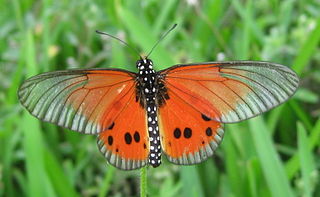
Acraea igola, the dusky-veined acraea, is a butterfly of the family Nymphalidae. It is found from the Eastern Cape along the coast to KwaZulu-Natal, Zimbabwe, Mozambique, north-eastern Tanzania.
In judo, improvement and understanding of the art is denoted by a system of rankings split into kyū and dan grades. These are indicated with various systems of coloured belts, with the black belt indicating a practitioner who has attained a certain level of competence.

Hypericum pulchrum is a flowering plant in the family Hypericaceae, commonly known as slender St John's-wort. It is native to Western Europe.
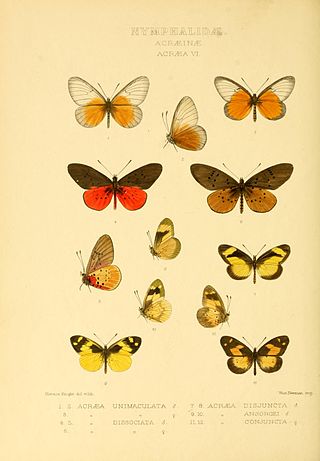
Acraea asboloplintha, the black-winged acraea, is a butterfly in the family Nymphalidae. It is found in the Democratic Republic of the Congo, Rwanda, Burundi, Uganda, Kenya and Tanzania.
Bematistes obliqua, the yellow-banded bematistes, is a butterfly in the family Nymphalidae. It is found in Nigeria, Cameroon, the Democratic Republic of the Congo and Uganda.

Acraea insularis is a butterfly in the family Nymphalidae. It is found on the island of São Tomé. The species was first named in 1893 by Emily Mary Bowdler Sharpe.

Acraea jodutta, the jodutta acraea, is a butterfly in the family Nymphalidae. It is found in Guinea, Sierra Leone, Liberia, Ivory Coast, Ghana, Togo, Nigeria, Cameroon, Equatorial Guinea, São Tomé and Príncipe, Gabon, the Republic of the Congo, the Central African Republic, Angola, the Democratic Republic of the Congo, Sudan, Uganda, Kenya and Ethiopia.
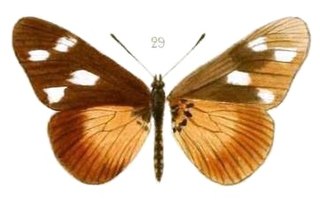
Acraea johnstoni, or Johnston's acraea, is a butterfly in the family Nymphalidae that is native to East Africa.
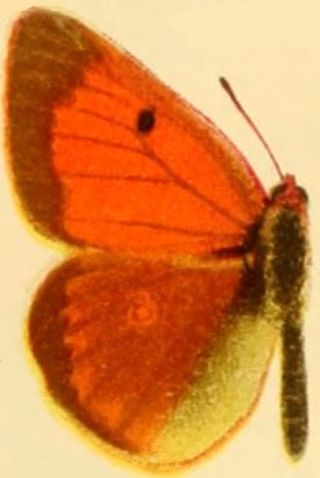
Colias heos is a butterfly in the family Pieridae. It is found in the East Palearctic.

Colias lesbia is a species of butterfly in the family Pieridae. It is found in the Neotropical realm.

Crameria is a monotypic moth genus in the family Noctuidae erected by Jacob Hübner in 1819. Its only species, Crameria amabilis, was first described by Dru Drury in 1773.
Heliothelopsis arbutalis is a moth in the family Crambidae. It was described by Snellen in 1875. It is found in Mexico and southern Arizona.
Pilocrocis dichocrosialis is a species of moth in the family Crambidae. It was described by George Hampson in 1912. It is found in Cameroon, the Democratic Republic of the Congo (Katanga), Malawi, Mozambique, Zambia and Zimbabwe.
Syllepte tetrathyralis is a moth in the family Crambidae. It was described by George Hampson in 1912. It is found in New Guinea.
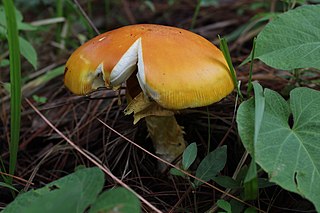
Amanita basii is a mushroom of the family Amanitaceae.














